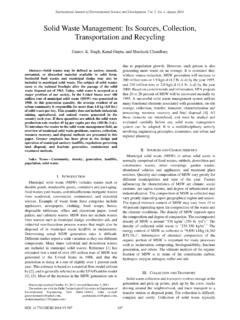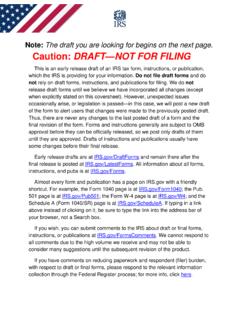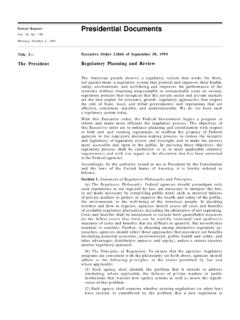Transcription of Lone Wolf Terrorism in America: Using Knowledge of ...
1 The author(s) shown below used Federal funds provided by the Department of Justice and prepared the following final report: Document Title: Lone Wolf Terrorism in America: Using Knowledge of Radicalization Pathways to Forge Prevention Strategies Author(s): Mark Hamm and Ramon Spaaj Document No.: 248691. Date Received: February 2015. Award Number: 2012-ZA-BX-0001. This report has not been published by the Department of Justice. To provide better customer service, NCJRS has made this Federally- funded grant report available electronically. Opinions or points of view expressed are those of the author(s) and do not necessarily reflect the official position or policies of the Department of Justice. This report has not been published by the Department of Justice.
2 Opinions or points of view expressed are those of the author(s) and do not necessarily reflect the official position or policies of the Department of Justice. Lone Wolf Terrorism in America: Using Knowledge of Radicalization Pathways to Forge Prevention Strategies Principle Investigators: Mark S. Hamm and Ramon Spaaij Indiana State University #2012-ZA-BX-0001. FINAL SUMMARY OVERVIEW. 1. This report has not been published by the Department of Justice. Opinions or points of view expressed are those of the author(s) and do not necessarily reflect the official position or policies of the Department of Justice. Abstract This research offers the largest and most comprehensive database ever created on lone wolf Terrorism , along with a theory-informed case study component based on direct contact with imprisoned lone wolf terrorists, and a comparative analysis distinguishing lone wolves from those who undergo radicalization in a group setting.
3 Strictly in terms of lethality, the data indicate that lone wolf Terrorism in America is not on the rise. Although lone wolf Terrorism may not be increasing, it is undergoing two important changes in modus operandi. First, uniformed police and military personnel have become the primary target of lone wolf terrorists. Second, consistent with the relaxation of gun laws since the 1990s and the recent trend in mass shootings, the lone wolf's preferred weaponry is now a staggering range of high-velocity firearms. While there is no standard profile of the lone wolf terrorist, most of them are unemployed, single white males with a criminal record. Compared to members of terrorist groups, lone wolves are older, less educated and more prone to mental illness.
4 The study validates a series of commonalities associated with pathways to radicalization for lone wolf terrorists. The radicalization model indicates that lone wolf Terrorism begins with a combination of personal and political grievances which form the basis for an affinity with online sympathizers. This is followed by the identification of an enabler, followed by the broadcasting of terrorist intent. The final commonality is a triggering event, or the catalyst for Terrorism . The ability of law enforcement and intelligence communities to detect and prevent lone wolf Terrorism demands a clear understanding of these radicalization processes. Such insight may provide investigators with a sort of detection system, or signatures as minimal as they may appear that an individual with a terrorist intent will demonstrate in preparing for an attack.
5 Crucial to this understanding is the broadcasting of intent. While lone wolves physically isolate from society, at the same time they seek recognition for their causes through spoken statements and threats, manifestos, e-mail messages, texting and videotaped proclamations. Focusing on this kind of immediate objective of radicalization among lone wolves, rather than on their underlying grievances, may sharpen our focus on the dangers posed by lone wolf Terrorism . 2. This report has not been published by the Department of Justice. Opinions or points of view expressed are those of the author(s) and do not necessarily reflect the official position or policies of the Department of Justice. Purpose of the project: The purposes of this research were to create a database of lone wolf Terrorism in America, along with a theory-informed case study component based on direct contact with incarcerated lone wolf terrorists, and a comparative analysis seeking to distinguish lone wolves from those who undergo radicalization in a group setting (See Appendix 1).
6 The objective of the study was to test the validity of a series of empirically-based commonalities associated with pathways to radicalization for lone wolves. Project subjects: See Appendix 2 for a discussion of methods used to recruit subjects. Project design and methods: To be included in the database and case studies, a case was required to meet the following definition: Lone wolf Terrorism is political violence perpetrated by individuals who act alone; who do not belong to an organized terrorist group or network; who act without the direct influence of a leader or hierarchy; and whose tactics and methods are conceived and directed by the individual without any direct outside command or direction. We discovered 98 cases fitting this definition between 1940 and 2013 representing all known cases of American lone wolf Terrorism for the period (see Appendix 3 for a list of cases).
7 Information on the 98 cases was gathered from an extensive review of previous research, biographies and memoirs, journalistic sources, government reports, court documents, encyclopedias and documentary films. The database catalogues the 98 cases across 21 different variables, generating 2,058 original data points. (Binary coding was used by a three-person team of raters who examined the variables.) It is the largest and most comprehensive database ever created on lone wolf Terrorism . Of the 98 cases in the database, 38 cases occurred before the terrorist attacks of 9/11 and 60 took place after 9/11. Of the 60 lone wolf cases after 9/11, however, 15 cases were law enforcement sting operations involving confidential informants and undercover agents; hence, 3.
8 This report has not been published by the Department of Justice. Opinions or points of view expressed are those of the author(s) and do not necessarily reflect the official position or policies of the Department of Justice. they do not qualify as authentic lone wolf cases since more than one individual was involved. The sting cases were nevertheless included in the database because stings against standalone extremists have become a major counterterrorism strategy since 9/11. Indeed, they have recently been employed by the FBI to identify Americans with an interest in becoming foreign fighters, including those who have attempted to join ISIS. The following analysis of post-9/11 cases excludes the 15 stings and concentrates only on the authentic cases.
9 In summary, the database includes 38 lone wolf terrorists between 1940 and 2000 and 45. (authentic) lone wolves between 2001 and 2013, for a total of 83 cases. By comparing the pre- 9/11 cases with the post- 9/11 cases across the full spectrum of 21 variables, we identify trends in lone wolf Terrorism and their underlying causes and potential control strategies for law enforcement. Data analysis: Based upon a descriptive analysis of the data, the major research conclusions are as follows. Trends in Lone Wolf Terrorism : From 1940 through 2000, the 38 lone wolf terrorists committed 171 attacks, claiming 98 lives and injuring another 305. An array of firearms and homemade bombs were used in the attacks. Roughly 60% of the lone wolves committed a single attack and 40% committed multiple attacks, including such prolific terrorists as Unabomber Theodore Kaczynski who committed 16 bombings over a 17-year period, the racist serial killer Joseph Paul Franklin responsible for an estimated 23 attacks over four years, and Muharem Kurbegovic, the Alphabet Bomber, who launched ten attacks in two years.
10 From 2001 through 2013, the 45 lone wolves committed 45 attacks, killing 55 people and injuring another 126. These attacks involved not only firearms and bombs but also airplanes, biological weapons, knives and construction equipment. In short, lone wolves have expanded 4. This report has not been published by the Department of Justice. Opinions or points of view expressed are those of the author(s) and do not necessarily reflect the official position or policies of the Department of Justice. their arsenal of weaponry in the post-9/11 era. While the multiple attackers were prominent in the pre-9/11 era, the single attacker rose to prominence after 9/11. They include such lone mass- murderers as Nidal Hasan who killed 13 and injured 30 in the 2009 Fort Hood shooting, Jared Laughner who killed six and wounded 13 in the Tucson shooting of 2011, and Wade Page who killed six and wounded four in the 2012 shooting at the Sikh temple in Oak Creek, Wisconsin.















